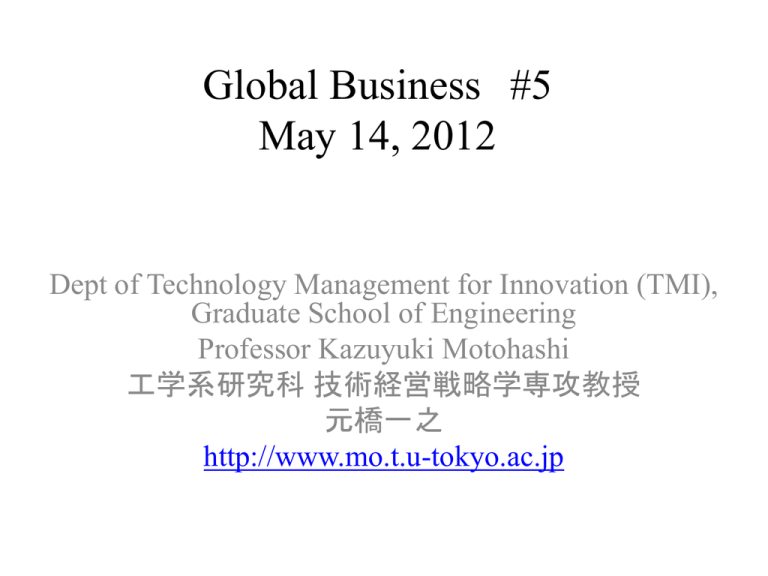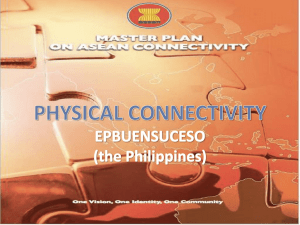1 - 元橋研究室
advertisement

Global Business #5 May 14, 2012 Dept of Technology Management for Innovation (TMI), Graduate School of Engineering Professor Kazuyuki Motohashi 工学系研究科 技術経営戦略学専攻教授 元橋一之 http://www.mo.t.u-tokyo.ac.jp Today’s class • What is complex service system? Why service model? • Global Infrasctuture business as an example • Business planning: practical guide and introduction to global business competition • Introduction to next class: case study on Neemrana Industrial Park Current issues in global business for emerging economies • Meta-manufacturing model: fast commoditization of product (catching up Korea, China etc.) -> complex system, service model • Importance in risk analysis for long-term business (operation and maintenance in infrastructure biz.) • Relationship with local government (business modeling for PPP) • Globalization of management style: Genchi-ka, proper balance between control and autonomy of local subsidiaries -> importance in human resources in global business Development in emerging economies Such as China and India New markets New competitors Global Business Strategy • Shift to “good enough market” and improvement in cost competitiveness • Business model re-organization by service dominant design World in not so flat, understanding distance Consistency with corporate strategy Product architecture and value creation Aircraft (CoPS) Size of value added Unbundling, competition Modularization Mainframe computer EV? Automotives Scalability in services? Service science PC Level of complexity (difficulty in imitation) IT services Difference in product architecture Integrated architecture Modular architecture Size of value added Growing “Good Enough Market” Driving forces PC Aircraft (CoPS) EV? Protection of propriety technology (IPR), increasing complexity, strategic Auto- in complex system investment motivesinnvation Scientific approach for innovation (digitalization, modularization..) and technological catching up Level of complexity (difficulty in imitation) What is complex service system? Local environment Value Proposition to the customer Organizational factors Low cost/ high performanc e Operation and Controlling Functions Complex system of products Complex system case: global infrastructure business • Infrastructure development needs in Asia until 2020 reaches $8 trillion due to urbanization (METI estimates). • Public money cannot cover such amount, so that PPP (public private partnership) is needed. • Analyzing infrastructure business is important • Risk analysis and simulation • Business modeling with relevant players Complexity in Global Infrastructure Business Product Design (Autos, PCs etc) Social System Design (GIB) Unit of observations (agents) Component, technology (such as IPR) Firms, government, NGOs etc Origin of complexity Interdependency of components and technology Interactions among different economic agents Objectives Balance of quality and cost Total profit maximization and winwin solution Inference approach Deductive Inductive Why? Natural Science Base Irregularity in organizational decision making process Analytical approach Top down from grand theory Learning by doing ex. Social experimentation, simulation Types of PPP Design • • • • • • Build Operation BOT (Build Operate Transfer): concession contract BOO (Build Own Operate) Leasing: Public leases out for private, affermarge Joint Venture Operations or management contract Cooperative arrangement: public supports to private Complex system of PPP project Host country Government Influence $$$(ODA) Japanese Government Contract Contractor Policy Project Company (SPC) Supplier Local Partner Customer Agent based modeling Dynamic linear programming Equity Investor Lender NPV Project Evaluation O&M (Operation and Management) Cash Flow EPC (Engineering, Procurement and Construction) T CFt NPV t t 1 (1 r ) IRR r ( NPV 0) Risk analysis of global infra project • Development of NPV model and monte carlo simulation • Risk management tools: trade insurance, project financing technique, etc IPP, Water, Waste Transportation (rail, road) Political Risk Regulatory framework + currency exchange risk, confiscation risk, risk contract breach, political violence, feedstock supply risk Commercial Risk Project completion risk, operation risk, + off taker risk (demand uncertainty) Natural force majure 『国際インフラ事業の仕組みと資金調達』(加賀隆一著)を著者加工 Analytical aspects by PPP Entity Goal/Contingency Key Variable Major risks Procurer Value for money/ failure in PPP project NPV of project Quality of public services Bid qualification Sponsor Return on Equity/ financial close Equity IRR Demand factors and cost factors (OPEX, CAPEX) Senior Lender Return on Loan/ delay and default of interest and principle Loan life cover ration (LLCR) Annual debt service cover ratio (ADSCR) Whole project risks but senior over equity and junior loan Example of optimization problem: Too high D/E ratio -> LLCR (ADSCR) shortage -> Require mezzanine loan -> higher financial costs -> Lower equity return The degree of procurer’s commitment to demand (electricity, ridership clause) -> lower contingency (like bankruptcy of SPV) -> make NPV of project higher Business Plan Competition : ASEAN ASEAN : factory and/or market for Japanese multinationals? Myanmar Laos Thailand Vietnam Cambodia Philippines Brunei Malaysia Singapore Indonesia Adapted from Financial Times Changing the landscape of Asia Comparative table in 2010 Japan 5,809 127 45.7 1,458 0.4 GDP Population GDP capita Trade Land ASEAN10 1,852 573 3.2 2,127 4.5 2010 Japan 38% billion US$ million K US$ billion US$ millon KM2 2030 NIES3 11% ASEAN 12% China 5,878 1,339 4.4 2,973 9.6 2050 NIES3 8% China 39% NIES3 7% ASEAN 15% Japan 20% ASEAN 20% China 57% Japan 11% China 62% Diversity in ASEAN countries (GDP per capita, unit: 1000 US$) Business Plan Items • Executive Summary • What is your company? (Hitachi group? or others? Start-up company?) • Management Team and Division of Labor • What kind of global business in ASEAN? And why – Summary of your new business – Business model of your proposal • Who’s your customer? • Market and competitor analysis – Risk analysis • Potential risks and contingency plan • Business execution planning (HOW) – Partnership with local players (with whom? why?) – Local operation – Marketing plan • Business Plan Evaluation (such as NPV, IRR analysis) 15 min presentation in the last class of this course Next class: Case study on Neemrana Industrial Park • Neemrana Industrial Park has been developed by cooperation of Japanese and Indian governments. What are reasons why both side of governments helped to develop this industrial park? • What are risks associated with investment in production sites in India? What are benefits located in Neemrana Industrial Park, in terms of lowering these risks? • Hitachi plans to extend “Neemrana Shared Energy Center (NSEC)” model to other region of India? Do you think whether Hitachi will succeed? • Do you have any recommendation in new business in India? What kind of business will be successful? You can extend a scope of your industry, not only in manufacturing, but also to trading companies, banks and logistics business.






